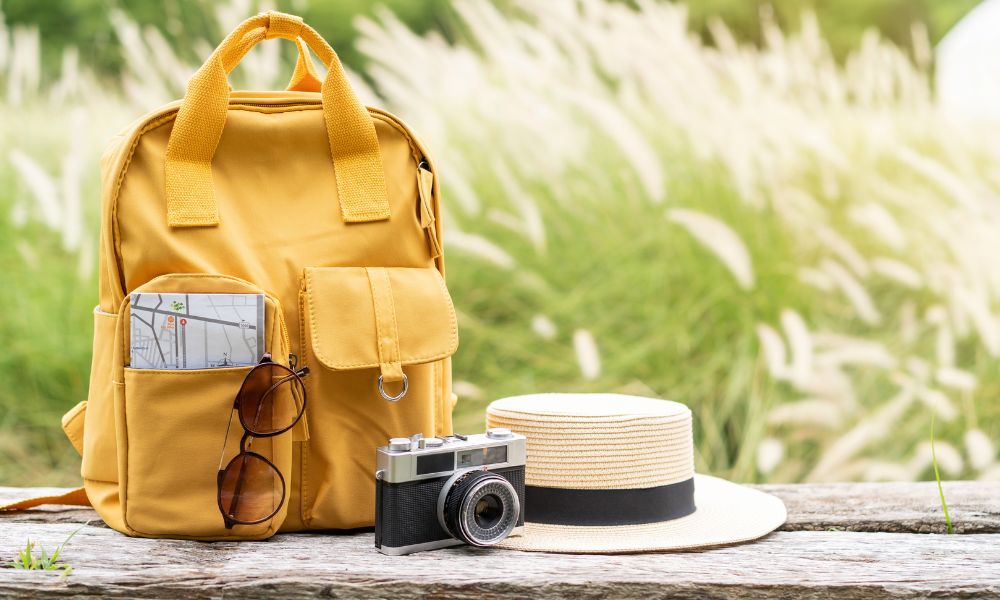For working professionals, campers, and students, the backpack is a must-have accessory for life. It’s the most convenient way to store supplies while on the go. However, there was a long journey to the current bags we recognize today. Here’s the complete history of the modern backpack for deeper insight.
The Beginning
Throughout history, people have carried things on their backs. With that, it may seem like a “no-brainer” that backpacks are an essential component of life. After all, the simple design seems like it was easy to integrate into society.
But several trials and errors made backpacks the functional accessories we currently use. That said, we can look back at backpacks in early times. In particular, the modern backpack dates to the 1880s.
The humble beginnings trace back to Norway around 1880. The “Sekk Med Meis,” which translates to a “bag with a frame,” was the earliest backpack. It was a wooden frame with a sack tied to it. It had one compartment and was a pioneer in travel gear (that we still use today). Although it influenced modern design, it was a unique item for its time.
In 1886, Colonel Merriam modified the frame design to transfer weight from the shoulders to the hips. The next significant progression came with the militarization of World War I. This event set the precedence for backpacks as we use them today, offering a way for someone to carry everything they need.
As you dive deeper into the backpack’s journey of popularization and functionality, some notable pioneers shaped the progression.
Timeline of Progress
Although it’s challenging to think about life without backpacks, there is an extensive timeline of designs, patents, and inventions before we get to modern carriers. Look at these prominent figures in the backpack world:
Henry Merriam
Henry Merriam made the first official move to create the modern backpack. In 1878, he issued a patent for the “knapsack,” a pack with an external sheet-metal frame. The knapsack was for the US Army and had unique qualities. It didn’t have shoulder straps, and the metal frame positioned the pack away from the soldier’s body. Merriam believed this would distribute loads evenly and free up people’s shoulders from straps. However, the design was uncomfortable and instantly fell out of popularity.
Ole Bergan
Ole Bergan was a Norwegian inventor. Around 1908, Bergan experienced sore shoulders while returning home from a hunting trip. He wanted a way to make backpacks more comfortable, so he bent a piece of juniper wood to follow the shape of his back. Thus, producing an ergonomic design for carrying his cloth bag. Eventually, Bergan replaced wood with tubular steel. This version of the backpack was popular for 20 years.
Lloyd Nelson
In 1920, outdoorsman Lloyd Nelson redesigned the backpack inspired by Indigenous people he met while on a trip to Alaska. Nelson designed a wood frame pack with canvas material. Furthermore, he used steel pins to attach a cloth bag. This gave users the choice to detach the bag. Known as the “Trapper Pack,” this was the first mass-produced carrier.
Gerry Cunningham
The first backpack with zippered closures came from Gerry Cunningham in 1938. Before this, buckles, pins, and straps secured packs. During this period, backpacks were for camping, hiking, and other outdoor activities. Cunningham was a rock climber and wanted to lighten his backpack load (while keeping items accessible). Thus, the zippered closures offered the right amount of practicality for outdoorspeople.
Ake Nordin
One thing to mention about early carriers is that people wore them low. However, functional advances helped modern bags. Transitioning to the 1950s, Ake Nordin sewed a small canvas bag that people could wear high and close to their backs. The soft pack stayed in place with leather straps fastened to a wood frame.
Dick and Nina Kelty
Around the same time as Ake Nordin, Dick and Nina Kelty improved backpacks too. They crafted frames from airplane aluminum (from World War II) and used parachute material as packs. These packs also included contour frames, padded shoulder straps, and waist straps. This advancement shaped the carriers that we know today!
Greg Lowe
In 1967, Greg Lowe created the first internal frame backpack. He noticed that external frame bags weren’t stable enough for large loads or rough terrain. He made a flexible bag that contoured to the person’s back (but was still strong enough to handle loads). Additionally, he incorporated compression and sternum straps into the backpack.
Gerry Outdoors
You can’t talk about backpacks without mentioning Gerry Outdoors. In 1967, he released the “teardrop” backpack, a lightweight nylon carrier. As far as outdoor lovers, the bag was immensely popular among campers, hikers, rock climbers, and others. However, it wasn’t popular with students (yet). JanSport changed the carrier game.
The JanSport Difference
JanSport released their version of lightweight, nylon bags in 1970. The company sold its carriers in a student sporting goods store at The University of Washington. Initially, the backpacks were for hikers, and the company assumed outdoor lovers would purchase the packs. However, students began using the bags to carry books on campus.
Before then, students would carry books by hand or tie them with a strap. That was labor-intensive and inconvenient. The trend of backpacks for books and school supplies soared across the country. Companies began creating backpacks to serve students of all ages!
Do People Still Use Older Backpacks?
Although external frame backpacks didn’t go extinct, they’re a rare sight on hiking trails these days. Some hikers still use them, but mainly for nostalgia purposes or enjoyment of retro aesthetics. However, the bags are durable with sizeable storage. The oversized pack is useful for some outdoor adventures (such as camping), but many people prefer compact carriers. So, do people still use older backpacks? Yes, they do. However, modern bags are the most popular contenders.
Today’s Backpacks
Today, backpacks generally fall into two categories: outdoor and academic. People use bags for outdoor adventures as it’s convenient to carry supplies on their backs. At the same time, backpacks are relevant for students as they store school supplies and books in them. But it’s important to acknowledge a shift in modern needs.
Now, schools rely more on digital tools like computers and tablets for learning. E-books are immensely popular, and designers are now rethinking backpacks. They’re creating smaller, sleeker bags with compartments for laptops and smart devices.
From the transition from oversized knapsacks to ergonomically designed carriers, backpacks have a deep history. Let our complete history of the modern backpack guide remind you of the interesting timeline of bags!
Speaking of carriers, Backpacks USA is your go-to place for wholesale kids’ backpacks. With attractive prints and cool shades, there’s something for everyone. Purchase your bags today.


